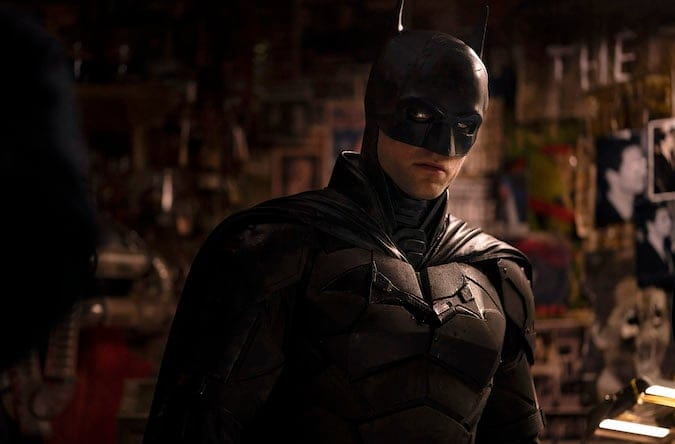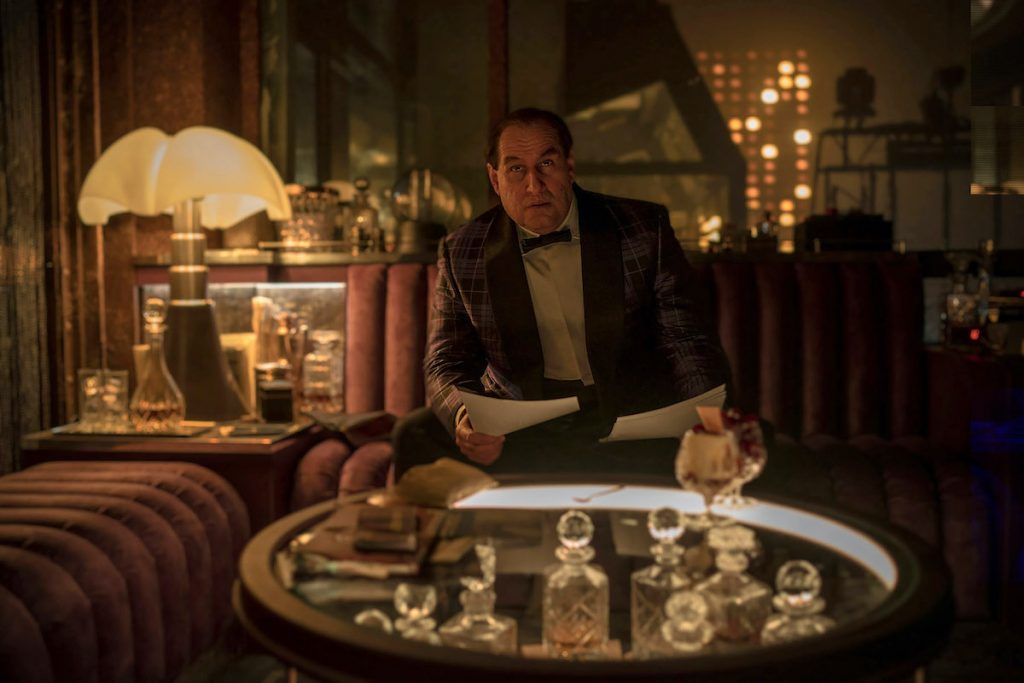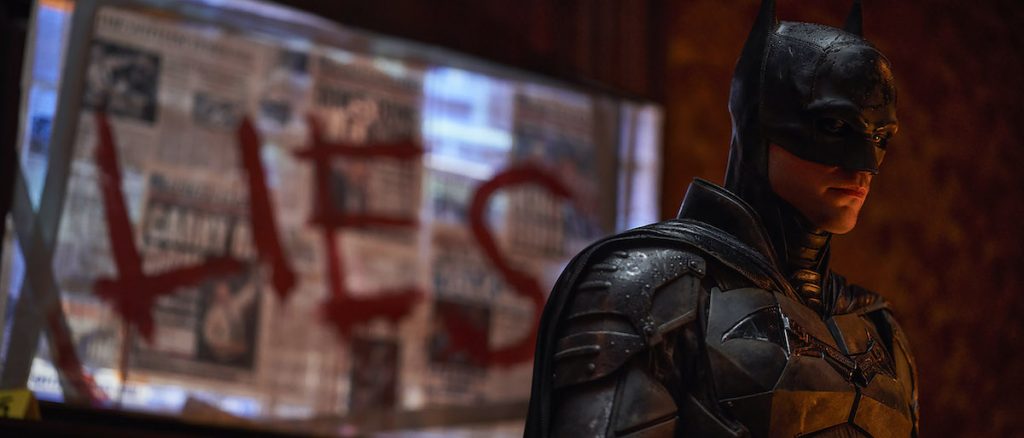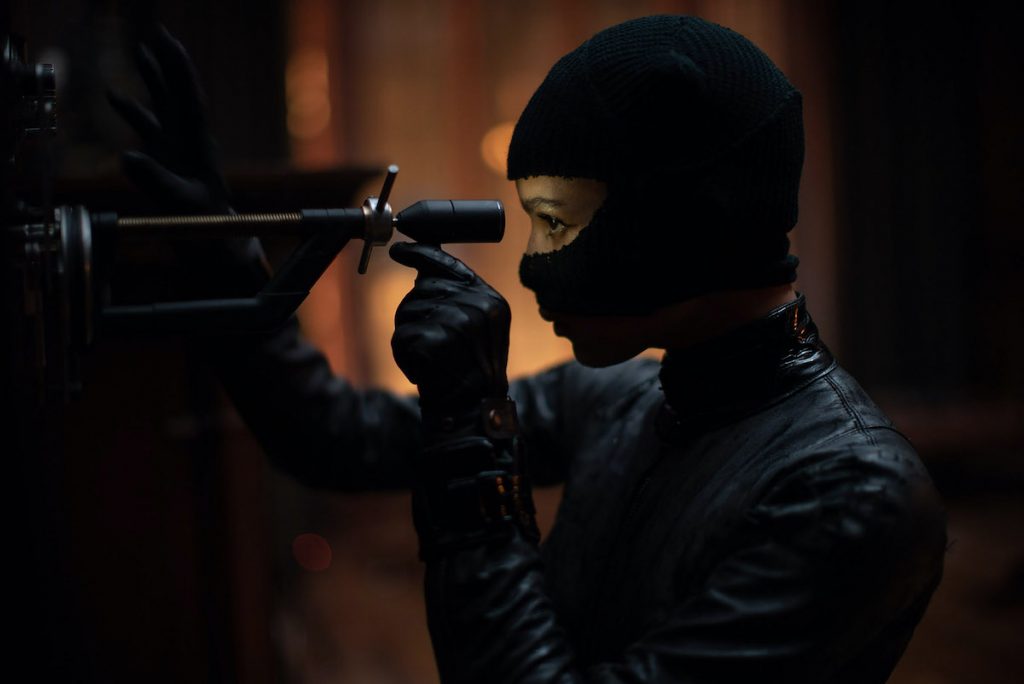
Ask Matt Reeves if there’s any significance to his use of the names Colson and Mitchell, and you’ll see how methodically he’s thought everything through.
“I wanted to do a story in which the corruption of Gotham was one of the most important aspects of the story, because Gotham is a sick place. Bruce is desperate to try and make a change,” says Reeves. “He’s still stuck, to be honest, emotionally stunted at being 10 years old, because that’s a trauma you don’t get past—witnessing your parents murder in this place.
“He’s looking to create meaning, right? This is the only meaning he can find. …I think he imagines that if he can do this, somehow he can reverse what’s happened, which will never be reversed. This is a very human impulse, right? To try and relive something and remake it.”
Reeves notes that from the first appearance of Batman — Detective Comics #27, published in May 1939 —creators Bob Kane and Bill Finger presented him as a noir figure, in line with the other hard-charging detectives of the novels, comics and films of World War II and the postwar era.
The comics would eventually come to describe him as the World’s Greatest Detective.
“This idea of a place that is corrupt, and you try to swim against the tide in order to fight against it and make a difference, is quintessential Batman. And at the center of those noir stories is almost always the detective, right? And that’s why he is the world’s greatest detective. And so this story is, in addition to being almost a horror movie, and a thriller, and an action movie, at its core, it’s also very much a detective story. It’s very narrative.”
Wright concurs: “Matt built an architecture within his script that was extremely well-considered.”
Pattinson was impressed that all the detective talk wasn’t just lip service.
“In the first meeting, he was saying, we want to lean into the ‘world’s greatest detective aspect,’ and be a detective noir movie,” he says. “And, you know, normally when directors say that, they just do like
a mood board, and it’s just about the imagery. But I read the script, and it is! It’s a detective movie. It happens all the time in the graphic novels, but it’s always kind of on the backburner in the movies.”
The film noir of the 1930s and ’40s was a major point of reference for Roman Polanski’s 1974 neo-noir Chinatown, in which Jack Nicholson’s cynical private detective, Jake Gittes, realizes that Los Angeles is even more crooked than he imagined.
“Chinatown is a kind of metaphor for just how corrupt we are,” says Reeves.
“And so I knew that this story was going to be, as he went on this path, to come to understand these crimes that he’s being led on by the Riddler — it needed to go back ultimately into a sense of expansive history that started to explain why this place was this way in a way that, while it starts seemingly on this path that’s impersonal, because he’s investigating these crimes, it ends up taking him in unexpected ways to something that was incredibly personal.”
He didn’t want to do another origin story — we’ve all seen Bruce Wayne’s parents die outside a theater, inspiring his crusade against crime.
“There had to be a very deep conspiracy going on. And so I watched All the President’s Men, I re-read the book, and I just started saying, OK, so how do we start to describe just how high the corruption went? It’s very much like All the President’s Men in that way.”
Enter another dark icon of the 1970s: the never-identified Zodiac Killer who taunted the Bay Area detectives who tried in vain to stop him. The Zodiac inspired The Riddler, played in The Batman by Paul Dano.

Colin Farrell as Oswald Cobblepot, who would prefer not to be called “the Penguin” in The Batman, from director Matt Reeves. Photos by Jonathan Olley/DC Comics
“The premise of the movie is that the Riddler is kind of molded in an almost Zodiac Killer sort of mode, and is killing very prominent figures in Gotham, and they are the pillars of society. These are supposedly legitimate figures. It begins with the mayor, and then it escalates from there. And in the wake of the murders, he reveals the ways in which these people were not everything they said they were, and you start to realize there’s some kind of association. And so just like Woodward and Bernstein, you’ve got Gordon and Batman trying to follow the clues to try and make sense of this thing in a classic kind-of-detective story way.
“I wanted bits of those names because I wanted the conspiracy to come with that forcefulness of history and believability for me,” Reeves explains.
Hence, Colson and Mitchell.
Follow the Money
All The President’s Men was the third film in Pakula’s “paranoia trilogy,” which began with 1971’s Klute. In the film, Jane Fonda plays a matter-of-fact call girl stalked by a killer. Donald Sutherland plays a private detective who tries to save her. He is smart and determined, but also naive.
Reeves and Kravitz talked about Klute a lot.
“That film kind of became a Bible for me in terms of tone and the relationship between the two of them, and that’s one of the most incredible performances I’ve ever seen—Jane Fonda just blows me away,” says Kravitz.
“Also, one of my favorite actors is Donald Sutherland,” says Reeves. “And what I love about Donald Sutherland in that movie is he judges her — he judges her and yet he falls in love with her.
“And I just thought that there was something about that, that related to what I thought could be a Batman-Selina Kyle story. He doesn’t understand… what it takes to survive in this place. What you have to do just to survive in a place this rough.”
Like Bruce Wayne, Selina Kyle has no super powers. Both rely on their tenacity, deductive skills, and courage. But Bruce is super rich, and Selina has nothing.
“Selina has had a very difficult life, and has lived on the street, and is trying to survive,” says Kravitz. “She really knows how scary the world is. Just based off of certain things that Batman says, she can tell he grew up wealthy.”
“It’s a really interesting dynamic, and yet, they are very similar. And that really is about them having similar values and being people who do want to take what they believe in into their own hands. They’ve both also felt like outsiders their entire lives. But I think she has a much harsher view of the world, maybe a nihilistic view.”
Reeves says Selina helps Bruce realize how much he’s taken for granted.
“It takes a very special safety net to even be able to do what he’s doing. Yes, OK: He’s risking his life, but he’s risking his life in the way that only someone who has all the resources that he has can do. He absolutely has privilege, there’s no question. He was born with privilege. He is a descendant of city royalty.
“I wanted him to have an awakening of sorts where he would question her about what she was doing,” he says. “And she says, you know, I don’t know who you are. But whoever you are, you obviously grew up rich.”
Overlooked
Then there’s that other well-regarded film from the 1970s. Reeves’ filmmaking heroes include Martin Scorsese, Alfred Hitchcock, Akira Kurosawa, Federico Fellini, and Francis Ford Coppola — whose The Godfather and The Godfather: Part II, widely regarded as two of the greatest films of all time, influenced The Batman in a surprising way.
Colin Farrell, like Reeves, first knew Batman from the campy TV series. One of the more outlandish characters in the Caped Crusader’s rotating rogues gallery of villains was The Penguin, portrayed by a scenery- and quellazaire-chomping Burgess Meredith as a grumpy, gaudy parody of an aristocrat, with a top hat, tuxedo, tails, monocle, long cigarette, and predilections for birds, ice, and bat-traps that never quite work.
Reeves saw him differently.
Colin Farrell’s Oz, who prefers not to be called The Penguin, is the shady proprietor of The Iceberg Lounge, a Gotham underworld hangout, doing the bidding of reclusive crime lord Carmine Falcone.
“There’s a certain amount of brokenness in Oz that, I think, as a reference, not for me performance-wise, but just emotionally, as a reference for Matt — I think Fredo from The Godfather was a bit of a reference,” says Farrell.
Played by John Cazale, Fredo Corleone is the weak son of Vito Corleone, who is stepped over by his more capable younger brother, Michael Corleone (Al Pacino), and in turn betrays him. Farrell’s performance is by no means an imitation of Cazale’s — he’s doing something entirely new, and is unrecognizable thanks to the work of makeup artist Mike Marino. But he shares Fredo’s sense of being stepped over.

Matt Reeves sees this Batman film, more than any other, as a detective story.
“Matt was just talking about somebody who had very real and very lofty ambitions, but never really had the opportunity or the chance to explore them, and was maybe looked upon as someone who was handicapped, whether it was psychologically, intellectually — Fredo was frowned upon as less than the other brothers, and maybe Oz as well, in his life, was looked upon as somebody who wasn’t capable,” says Farrell. “And so that’s one of the things that fuels Oz.”
Memory Cloth
While Batman may share moral clarity and mental acuity with Jake Gittes, Woodward and Bernstein, and John Klute, none of those screen heroes share Batman’s peculiar modus operandi.
Bruce Wayne is a man for whom, for some reason, bat-ears feel essential to the war on crime.
One reason the Batman TV show worked so well — with its bright, skin-tight costumes, punny exchanges, and the BAM!-SOCK!-POW! fight scenes — is that it acknowledged the absurdity of a man dressing up in tights to battle a penguin impersonator, a succession of Catwomen, and a Joker played by a makeup-caked actor (Cesar Romero) who couldn’t be troubled to shave off his mustache. It was a playful comedy.
Tim Burton’s Batman films celebrated the grotesquerie of Gotham, treating Batman as a kind of earnest, steely ringmaster trying to corral a menagerie of freaks. His Batsuit looked restrained compared to Nicholson’s tacky Joker, Danny DeVito’s ghastly Penguin, and Michelle Pfeiffer’s glossy, mischievous Catwoman. Joel Schumacher’s Batman films went for comedy again, embracing garish colors, hammy performances by the likes of Jim Carrey as The Riddler and Arnold Schwarzenegger as Mr. Freeze, and, at Batman’s cinematic low point, a nippled Batsuit.
Christopher Nolan’s Dark Knight trilogy pulled things hard back to reality, coolly and logically justifying even the most bizarre aspects of the Batman myth. In Nolan’s Batman Begins, inventor Lucius Fox (Morgan Freeman) understatedly introduces a lightweight fabric called “memory cloth” that might be helpful for “BASE-jumping.” It becomes the cape that helps Batman (Christian Bale) leap from tall buildings. Other accoutrements are similarly justified. Why does he dress like a bat? “Bats frighten me,” Bale’s Bruce Wayne explains. “It’s time my enemies share my dread.”
No matter how well-made they are, one thing that tends to separate Batman movies from the kinds of films that Oscar voters like is the idea of a vigilante disguising himself as a scary animal, a childish image many cineastes just can’t get past.
“Even in the early comics, there was something which I really liked,” says Pattinson. ”In a lot of the early tellings of it, he’s just sitting at home and a bat just smashes through the window, and he’s like, ‘That’s it!’ I’ll be a bat!’”
He laughs. “That doesn’t make any sense whatsoever.”

Zoё Kravitz as Selina Kyle, aka Catwoman, in The Batman, directed by Matt Reeves.
The Batman script, Pattinson explains, finally embraces the madness. “There’s an element in the other iterations of the story where Bruce goes off, does his training, masters himself and then comes back to Gotham as a fully realized character and the delineation between Bruce and Batman — the public Bruce, the private Bruce, and the Batman Bruce — are very contained and he can control them more easily,” says Pattinson. “And in this, the lines have totally blurred. His self as Bruce is sort of disintegrating.”
After his massive breakout success in the Twilight movies, Pattinson took care to prove himself outside of big franchises. He disappeared into the role of a bearded, bespectacled, deeply beleaguered early 20th century explorer in James Gray’s 2016 film The Lost City of Z, and the next year played ferociously against type as a desperate criminal dirtbag in Josh and Benny Safdie’s mesmerizing crime thriller Good Time. Then he signed up for The Lighthouse, Robert Eggers’ slow-burn, black-and-white horror film.
Reeves and The Batman producer Dylan Clark took note.
“We’re like, he’s just making insanely bold choices, this guy. He went from being, very early on, in a giant franchise where he was a poster boy, to really pushing himself as an actor, working with incredibly talented directors and pushing himself all the way. And we just respected that,” says Clark.
Clark and Reeves started working together after Rupert Wyatt, director of the 2011 reboot Rise of the Planet of the Apes, didn’t return for a sequel. Clark, producer of the recent Apes films, met with Reeves, who went on to direct both 2014’s Dawn of the Planet of the Apes and 2017’s War for the Planet of the Apes.
“He loved the Planet of the Apes television series. And my grandfather produced that,” Clark recalls. “The level of detail that he knew about the TV show was mind-blowing. He’s just a savant in those kinds of ways. The thing that just endeared me to him was just how emotional he felt about those characters on the TV show. And he loved what we had done with Rise.”
Continue for more of Matt Reeves on The Batman
Share:

